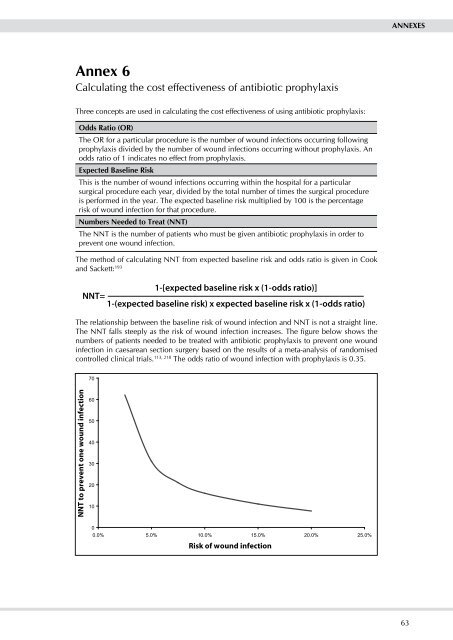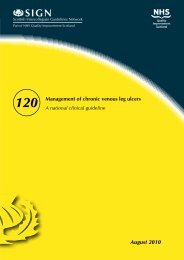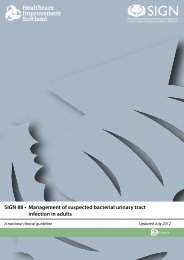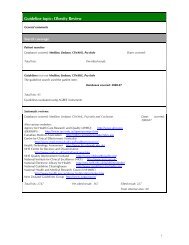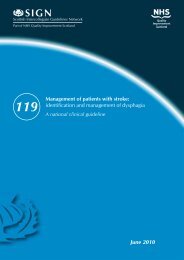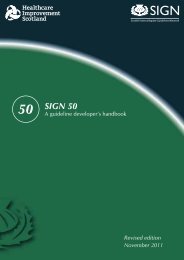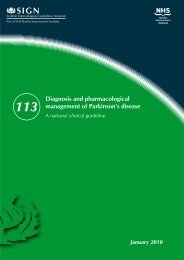Antibiotic prophylaxis in surgery. (SIGN Guideline No 104)
Antibiotic prophylaxis in surgery. (SIGN Guideline No 104)
Antibiotic prophylaxis in surgery. (SIGN Guideline No 104)
You also want an ePaper? Increase the reach of your titles
YUMPU automatically turns print PDFs into web optimized ePapers that Google loves.
Annex 6<br />
Calculat<strong>in</strong>g the cost effectiveness of antibiotic <strong>prophylaxis</strong><br />
Three concepts are used <strong>in</strong> calculat<strong>in</strong>g the cost effectiveness of us<strong>in</strong>g antibiotic <strong>prophylaxis</strong>:<br />
odds ratio (or)<br />
The oR for a particular procedure is the number of wound <strong>in</strong>fections occurr<strong>in</strong>g follow<strong>in</strong>g<br />
<strong>prophylaxis</strong> divided by the number of wound <strong>in</strong>fections occurr<strong>in</strong>g without <strong>prophylaxis</strong>. An<br />
odds ratio of 1 <strong>in</strong>dicates no effect from <strong>prophylaxis</strong>.<br />
expected basel<strong>in</strong>e risk<br />
This is the number of wound <strong>in</strong>fections occurr<strong>in</strong>g with<strong>in</strong> the hospital for a particular<br />
surgical procedure each year, divided by the total number of times the surgical procedure<br />
is performed <strong>in</strong> the year. The expected basel<strong>in</strong>e risk multiplied by 100 is the percentage<br />
risk of wound <strong>in</strong>fection for that procedure.<br />
numbers needed to treat (nnt)<br />
The NNT is the number of patients who must be given antibiotic <strong>prophylaxis</strong> <strong>in</strong> order to<br />
prevent one wound <strong>in</strong>fection.<br />
The method of calculat<strong>in</strong>g NNT from expected basel<strong>in</strong>e risk and odds ratio is given <strong>in</strong> Cook<br />
and Sackett: 193<br />
1-[expected basel<strong>in</strong>e risk x (1-odds ratio)]<br />
NNT=<br />
1-(expected basel<strong>in</strong>e risk) x expected basel<strong>in</strong>e risk x (1-odds ratio)<br />
The relationship between the basel<strong>in</strong>e risk of wound <strong>in</strong>fection and NNT is not a straight l<strong>in</strong>e.<br />
The NNT falls steeply as the risk of wound <strong>in</strong>fection <strong>in</strong>creases. The figure below shows the<br />
numbers of patients needed to be treated with antibiotic <strong>prophylaxis</strong> to prevent one wound<br />
<strong>in</strong>fection <strong>in</strong> caesarean section <strong>surgery</strong> based on the results of a meta-analysis of randomised<br />
controlled cl<strong>in</strong>ical trials. 113, 218 The odds ratio of wound <strong>in</strong>fection with <strong>prophylaxis</strong> is 0.35.<br />
NNT to prevent one wound <strong>in</strong>fection<br />
70<br />
60<br />
50<br />
40<br />
30<br />
20<br />
10<br />
0<br />
0.0% 5.0% 10.0% 15.0% 20.0% 25.0%<br />
Risk of wound <strong>in</strong>fection<br />
Annexes<br />
63


